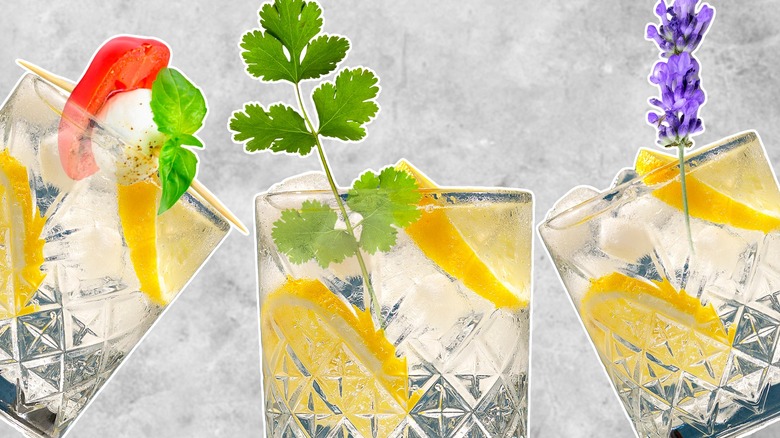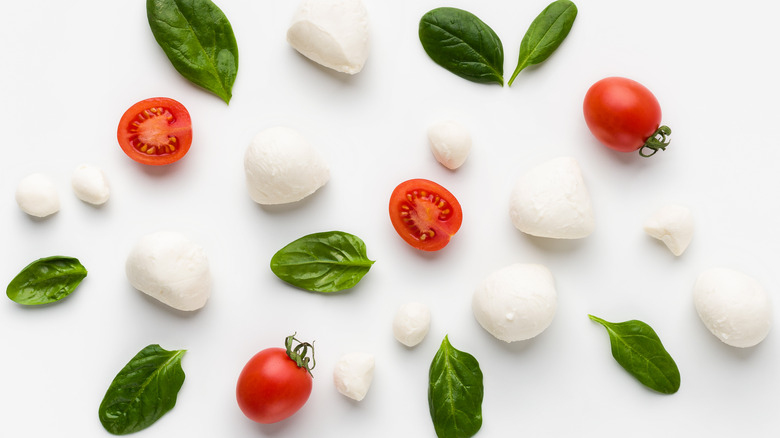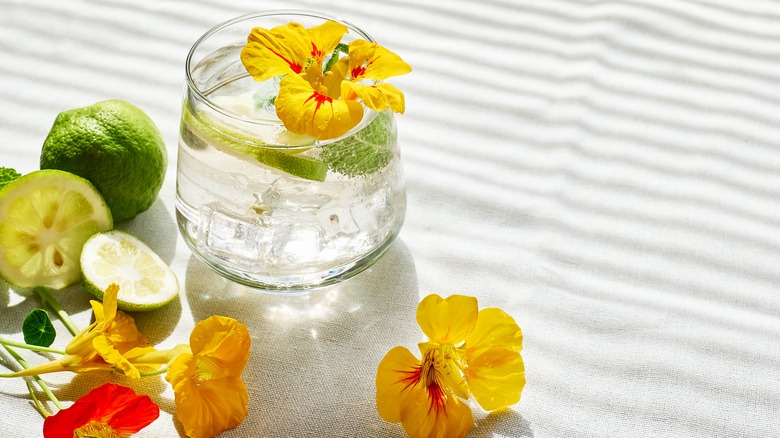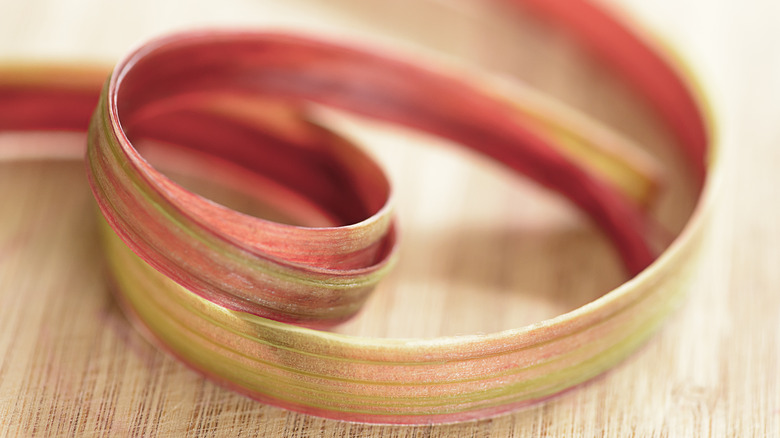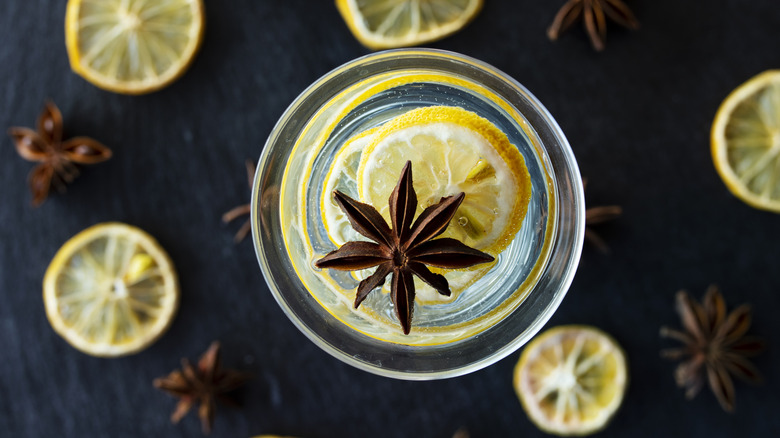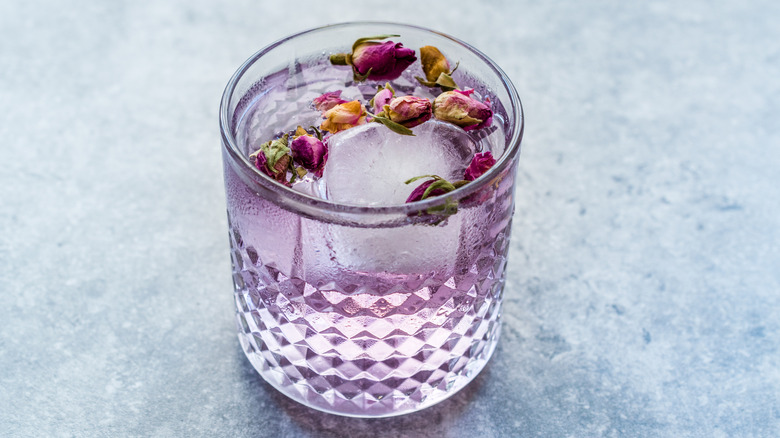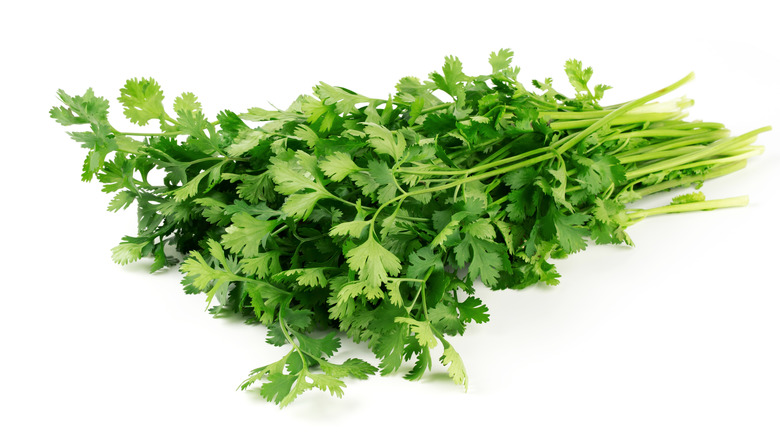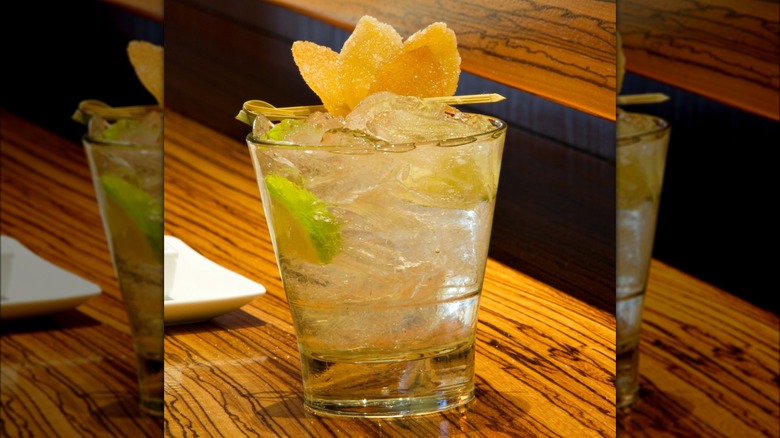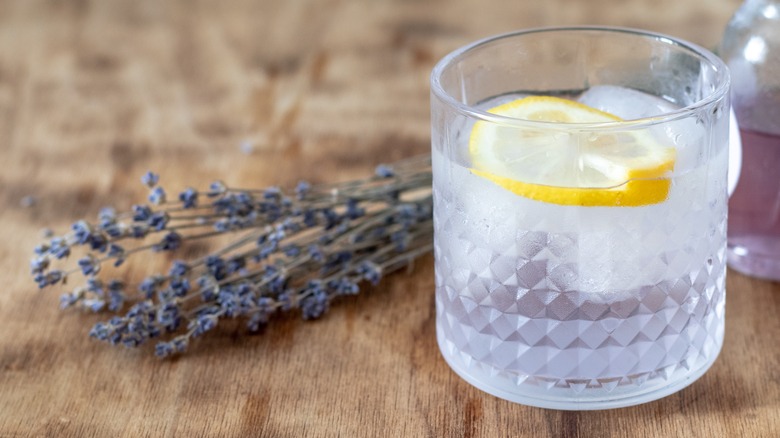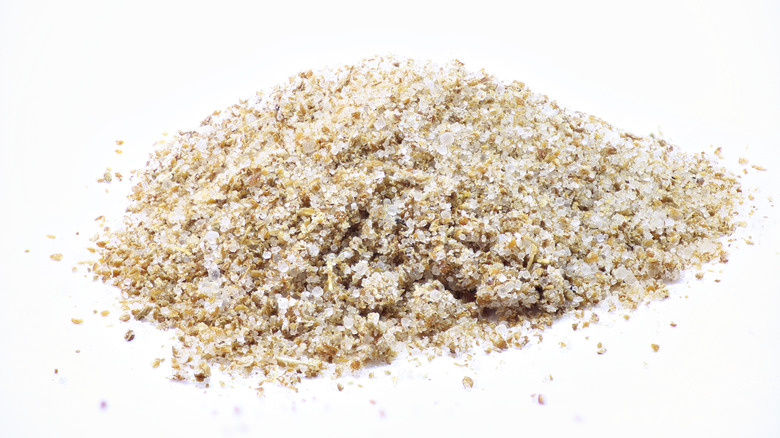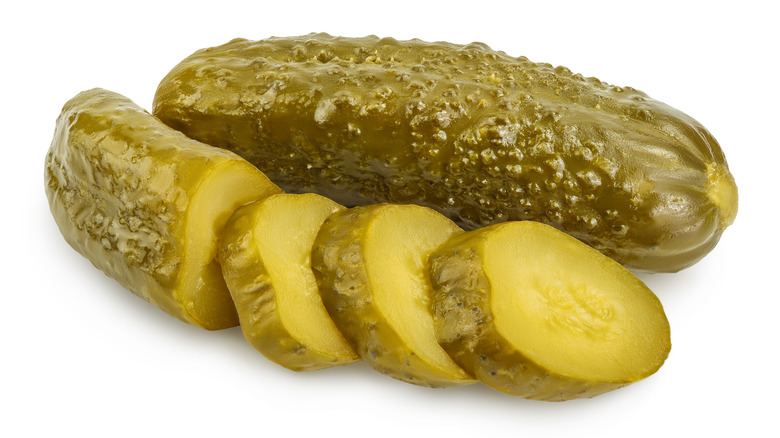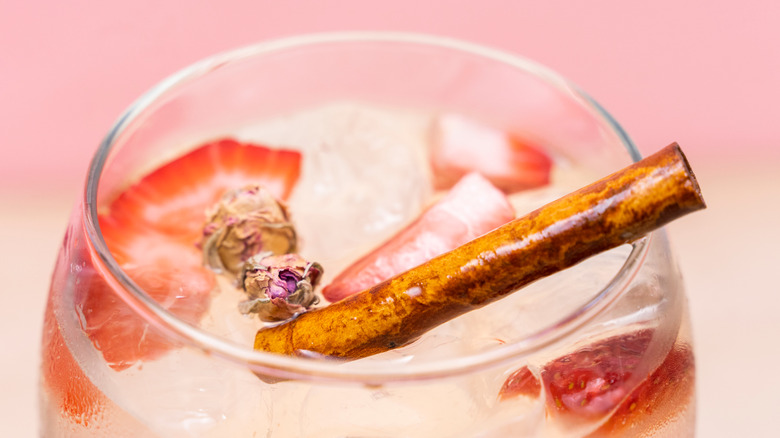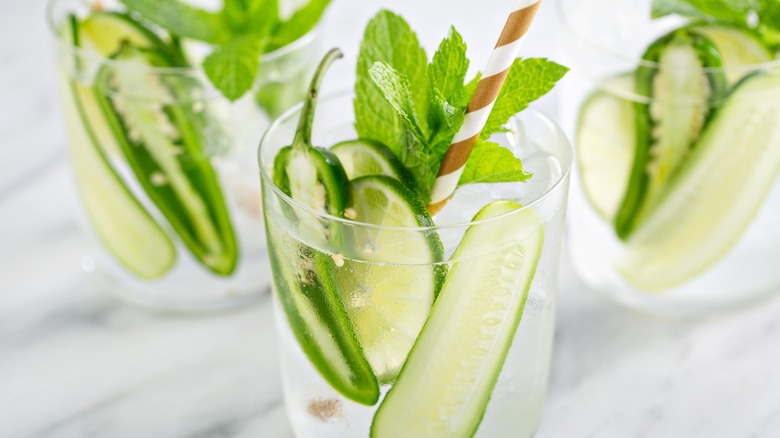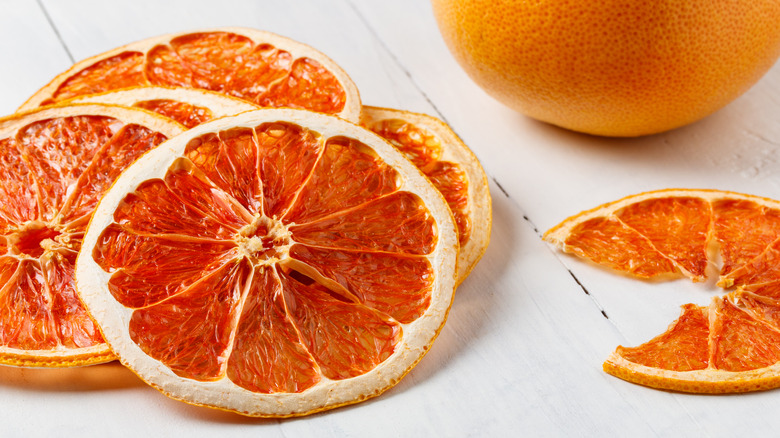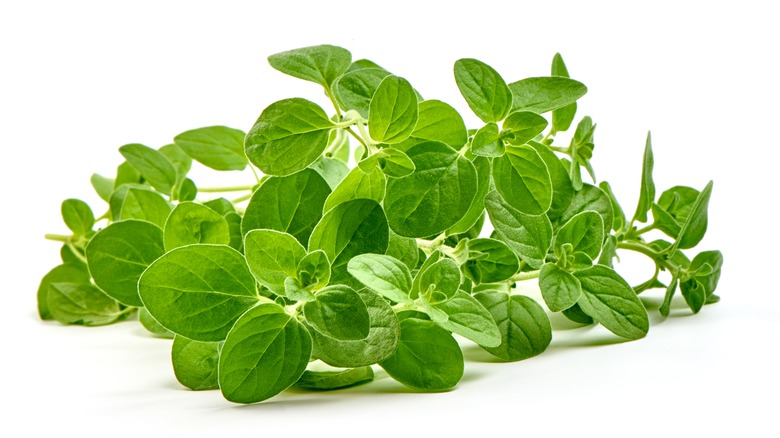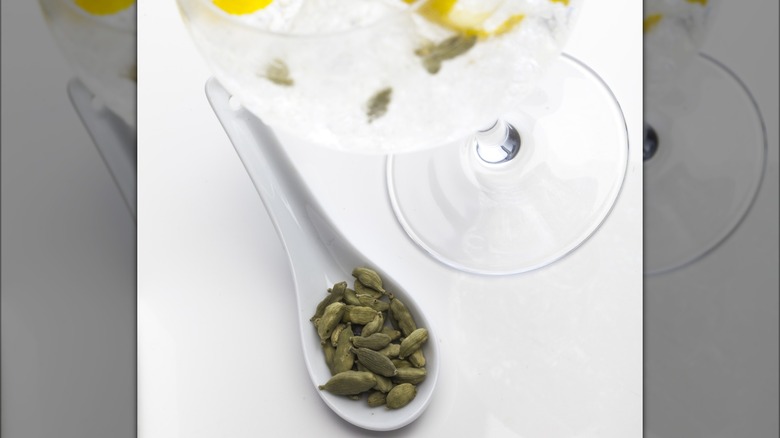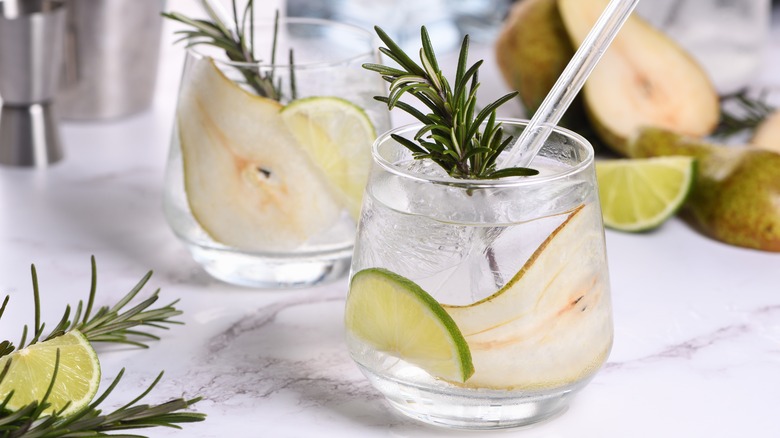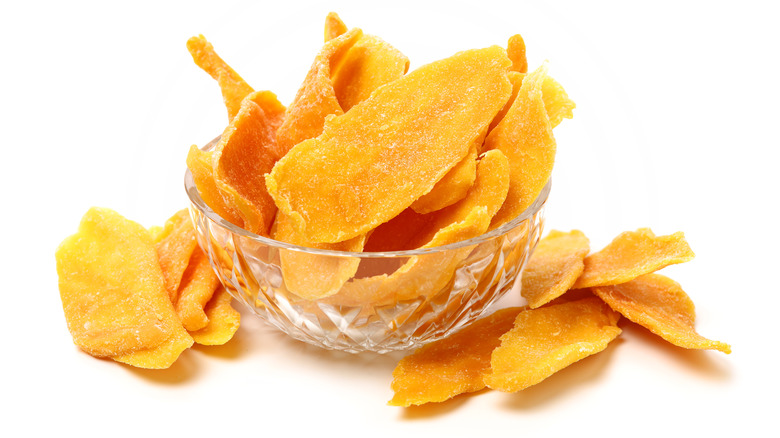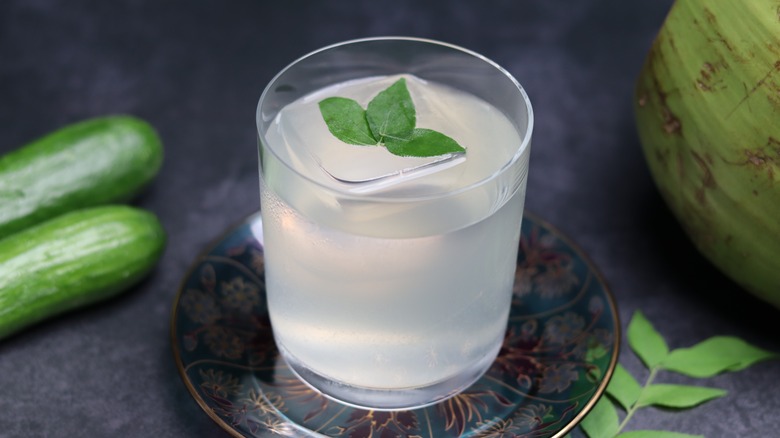18 Creative Garnishes For Your Gin & Tonic
While their visual appeal is obvious, there is an actual reason cocktails are served with a garnish and even simple mixed drinks like the humble gin and tonic benefit from a little panache. Edible garnishes can contribute to flavor or texture, while aromatic garnishes add complexity by telling the olfactory side of the story. Some garnishes contrast the gin or tonic water, while others strike a beautiful harmony of complementary characteristics.
It's time to take a fresh look at this playful element and find some truly creative garnishes for your gin and tonic beyond the tired old lemon wheel or rosemary sprig. In my time working in gin sales and marketing, as well as years in retail and hospitality, I got to learn the tricks of the trade and get an in-depth understanding of the magic of the gin and tonic. With that experience in mind, the most creative garnishes I've seen or tried are ones that take a simple G&T to the next level. You may even find some promising combinations among these, but remember, less is more when it comes to garnishing drinks.
Caprese skewer
In the world of garnishes, it can be easy to get a little bit carried away. Sometimes, however, that's not such a bad thing if you do it with a touch of flair. A caprese skewer is simple, eye-catching, delicious, and molto Italiano.
This garnish gets its inspiration from the Caprese salad comprising tomato, fresh basil, and mozzarella. Lined up on a toothpick or short skewer, these ingredients look bellissimo atop a frosty gin and tonic. For the mozzarella, you can use tiny bocconcini balls as well as cherry tomatoes, along with one or two leaves of fresh basil.
This is best suited for drier gins, such as those of the London dry persuasion or those that predominantly feature herbaceous, savory botanicals. It would make a dashing Spanish-style "gintonic," which often features all kinds of whacky garnishes and good-quality tonic. Let the mozzarella drip off some moisture before topping your tonic to avoid having brining liquid in your cocktail, and choose a glass with a narrow opening so the garnish does not soak in the spirits.
Nasturtium flowers or leaves
A common colorful touch in fine dining, nasturtiums can also add depth of flavor and aroma to a gin and tonic. Both its lilypad-shaped leaves and whole flowers are edible and have an intriguingly hot, peppery, and herbaceous flavor. The taste of nasturtium can best be compared to the kick of a radish. Nasturtium flowers typically come in bright hues of red, orange, and yellow.
Nasturtiums are well-suited to citrus-forward gins and those featuring herb and spice botanicals, like rosemary, black pepper, cubeb, or grains of paradise. Similarly, drier tonic with higher levels of quinine can also stand up to the bite of nasturtiums. To serve, you can simply drop a flower, leaf, or both into the glass. For extra points, you can trim the wide, flat leaves into shapes using a cookie cutter or stencil. Nasturtiums can also be colorful accompaniments to other garnishes that complement a drier profile gin and tonic.
Rhubarb ribbons
Adding a sleek touch of class to your gin and tonic is actually easier than you may think, especially if you have a rhubarb stalk and a fruit peeler handy. One garnish you may see in fancy bars (but that's as easy to make as peeling a carrot), is a rhubarb ribbon, elegantly winding around the inside of the glass. Simply cut thin slices down the length of a rhubarb stalk to crate your own tangy red ribbons, and curl them around the inside of your glass before you add the ice and the gin and tonic.
Uncooked rhubarb is incredibly tart, so reaching for a fruity gin can help play sweet and sour off each other for balance. Similarly, a sugary tonic can also help to harmonize rhubarb's sourness. While rhubarb stalks are safe to eat uncooked, don't get zealous with the whole plant, as the leaves of the rhubarb plant are toxic.
Star anise
In case you don't know what star anise is, this small spice is a visually intriguing, aromatic twofer. Commonplace in East Asian and Southeast Asian cuisine, it lends its distinctive licorice-like flavor and aroma. On top of a gin and tonic, a star anise seed pod helps the drink feel spiced and rich.
While not edible in a cocktail or mixer, the aroma that star anise provides as a garnish helps to add depth to the drink. Star anise is best with gins that have a generous level of baking spices such as cassia or nutmeg in their botanical lineup, as well as gins that hero citrus notes. When using whole dried spices as a garnish, you should start toasting your spices for more expressive aromatics and a deeper flavor. Doing this can elevate the star anise from being just a pretty decorative asterisk on your drink to being a fragrant star of the show.
Dried rosebuds
This next garnish adds a literal flourish to a gin and tonic. A few dried rosebuds sprinkled over a G&T lends color and elegance while making the drink look at least five dollars more expensive. Dried rosebuds may contribute subtle aromas, not as pungent as fresh flower buds, but still adding to the bouquet with each sip. These garnishes are not intended to be edible, but after sitting in the drink for a while, they may give a rosewater quality to the gin and tonic. With that said, for best results, drop your rosebuds onto the drink immediately before serving. Nobody prefers a glass full of drowned flowers.
Some gins already taste quite floral, and these make the best choices for this primarily visual garnish, creating a satisfying congruence between what you see and what you taste and smell. Dried rosebuds can be bought for the purpose of garnishing, or can be picked up from well-equipped tea stores.
Fresh cilantro
There are few herbs as divisive as cilantro, also known as coriander. To some, it's an aromatic, fresh, and herbaceous garnish. To others, it's just a nasty weed that tastes like soap. For the fans, what makes cilantro so appealing on a taco or curry is how generously fragrant the fresh herb is. This same quality makes cilantro a powerful garnish on drinks, such as your gin and tonic. It's bright green and makes a frosty drink feel fresher.
While dried coriander seeds and fresh herb have their own qualities, the relationship between these two forms of cilantro can help decide when to choose the garnish. Coriander seeds are classic botanicals in popular gins such as Bombay Saphire and Tanqueray London Dry Gin. Cilantro is also often buddied up with lime in Mexican cuisine, and this harmonious friendship lends the herb to citrus-forward gins as well.
Candied ginger
The best edible garnishes are those that offer an elevated moment, taking your attention away from the drink for a split second before making the return journey rewarding. With the right gin and tonic, candied ginger can deliver a brief kick of intense gingery sweetness that improves the flavor of the G&T.
There are gins that use ginger as a botanical, although these aren't as common. Coriander seeds contain the essential oil linalool, which can even have a candied ginger quality, meaning that gins that use this botanical can be a great match. Alternatively, gins that have elevated spice, citrus, or fruit notes can all go well with a candied ginger garnish, as can higher-quinine tonics. For best results, place a few small pieces of candied ginger onto a skewer and place this on top of the glass to keep them out of the drink and let the aromas hang in the air.
Lavender flowers
The great thing about lavender is that it smells almost as good as it looks in the glass. What's more, lavender is about as easy to use as possible for a garnish. By simply sprinkling the tiny lavender flowers over your drink, or even sticking a stalk of lavender flowers into the glass, you can easily elevate your gin and tonic with the flower's distinct character.
Part of what makes lavender so popular with gin is perhaps the combination of qualities that make it at once herbal and floral. Lavender is, in fact, in the family Lamiaceae, alongside aromatic herbs like basil, mint, rosemary, oregano, and thyme. At the same time, its perfumed aroma makes lavender a strong addition to a G&T. Lavender can form a fragrant bridge with floral gins while also contributing its own levity to balance more herbaceous or spice-forward gins. Both drier and sweeter tonics work equally well with lavender.
Celery salt
Celery salt has long been the favored rim dressing on bloody marys, but its talents do not end with tomato-based mixers. While salt rims on gin and tonics aren't as common, a portion of the glass coated with celery salt can add intrigue and depth to a few featured sips. This allows you to enjoy a few gulps without the salt and some with, enhancing the drink's sensation of refreshment. To create the salt rim, rub the juice of a lemon along the portion you wish to coat with celery salt, press this section into a shallow dish of celery salt, and leave it to dry.
Aside from its obvious saltiness, celery salt is vegetal and herbaceous, best suited to gins that express the same qualities or even those with prominent cooking spice botanicals. For a particularly good celery salt-rimmed G&T, look for some cucumber-flavored tonic and a London dry gin.
Dill pickles
There aren't many things in life that can't be improved by introducing a crunchy pickle. A dry G&T is just begging to get the same briny, tangy treatment as other pickle juice cocktails, such as the dill pickle martini, and indulgences like the pickleback shot.
A dill pickle is a simple garnish to administer to a gin and tonic. One method is to slice a pickle lengthways into spears that you can poke down the side of the glass or rest on top. Another method is to slice the pickle into wheels, placing them on the rim or the top of the drink. To get extra creative, you can weave a thinly sliced pickle ribbon onto a skewer around other tangy delights, such as pickled onions or other vegetables. The acidity of pickle juice and the herbaceous flavor of dill means that drier gins and tonic waters are the best counterparts for this garnish.
Toasted cinnamon quill
While the humble gin and tonic tend to fall out of vogue in the chillier months, a well-selected garnish can make a more festive version of the refreshing beverage for the holiday season. Poking a toasted cinnamon quil into your gin and tonic can add a touch of warming spice and enhance the citrus or fruit in the gin.
Toasting the cinnamon elevates this simple garnish that step further. As with other whole-spice garnishes on this list, giving your quills a brief dry toasting in a pan or in the oven can help to improve their fragrance. This can also help to elevate any cooking spice notes from the gin itself while infusing the drink with cinnamon warmth. Toasted cinnamon is a delicious complement to sweet flavors, and sweeter gins and tonic waters can work well. Tonics with grapefruit or orange flavor pair splendidly with this garnish.
Fresh jalapeño
For too long, the spicey margarita has hogged the limelight of jalapeño-garnished beverages. A fresh jalapeño is fragrant, fresh, and spicey enough to add a satisfying lick of heat to a refreshing G&T. Simply cut a few slices and drop them onto your drink, or slice down the pepper lengthways to create a strip to go down the side of your glass. The former is best for adding that firey jalapeño aroma, while the latter is great for infusing heat into the drink itself.
Fans of Mexican food will know that where there's jalepeño, there's often lime. Gins with pronounced citrus, particularly lime, make for excellent jalepeño-topped G&Ts. The sugar in sweet gin and tonics can quell some of jalepeño's flames, while the pepper can also elevate the botanicals in a dry gin as well. You can always drop in a squeeze of fresh lime for good measure.
Dehydrated grapefruit
The wheels of dehydrated citrus that crown the tops of fancy cocktails are actually easier to make than many people realize. The combination of gin and grapefruit is a famous friendship, meaning that dehydrated grapefruit wheels make a cohesive and visually appealing garnish.
Grapefruit is extremely tart and much more bitter than other sweeter types of citrus such as orange or tangerine. This quality helps grapefruit balance sweeter G&Ts, or add levity to drier spice-driven ones. Gins with a strong citrus element are also excellently complemented by a dehydrated grapefruit wheel.
The quickest way to make these is to wash your grapefruit well before slicing it into thin wheels. Lay the slices out on a baking paper-lined tray or wire rack and bake in the oven at 200 degrees Fahrenheit for up to six hours. Drying your citrus for longer periods at lower temperatures can help preserve the fruit's color.
Oregano sprig
Thyme is a popular garnish to grace a herb-laden glass of gin and tonic, but its cousin, oregano, is not to be overlooked. Oregano is highly fragrant, with a lush, green, herbaceousness that elevates a Spanish-style gintonic in both look and aroma.
Synonymous with Italian food, oregano (you can decide which syllable gets the emphasis) comprises short, thin sprigs with tiny leaves. Oregano plays remarkably well with citrus, making gins in this style a worthy dancing partner, as well as those with herbal or peppery botanicals.
An elegant way to use oregano as a garnish is to simply dress the drink with a few sprigs, poking them into the ice or down the side of the glass. Tonics with grapefruit or another citrus flavor can add complementary notes and appealing color to an oregano-dressed G&T. In the bowl of a Spanish gintonic glass, the delicate aromas of fresh oregano should suffuse the air over the drink.
Toasted cardamom pods
Another spice that benefits from the touch of a toasting pan is cardamom, making for a highly fragrant G&T garnish. Green cardamom is the more common variety for cooking, with its chai-like aroma and flavor that you may recognize from Indian cuisine. Interestingly, cardamom is related to ginger as a member of the Zingiberaceae family.
After giving a few whole cardamom pods a brief toasting in a hot pan or oven, they can simply be placed on the top of a G&T. Be careful not to swallow them, and consider drinking with a straw to drink from the bottom of the glass, as the pods tend to float. As a common spice to flavor Indian and Middle Eastern foods, as well as European pastries, cardamom's capacity for pairing with gin is quite versatile. Gins with baking spice-heavy botanical lineups make great G&Ts for a cardamom garnish. Floral gins and tonics also pair excellently.
Pear
Not only does pear offer a sweet and fruity edible garnish, but it also acts like a sponge, soaking up the drink for a boozy final bite. Submerging the pear is a good idea, as just like apples, pears can oxidize quickly and turn brown. If you'd prefer to have artful pear slices as a garnish, soaking the slices in lemon water for a few minutes can help prevent this oxidization and keep them looking fresher for longer. This also adds an extra citrus element, which, in the right G&T, can be quite pleasant.
A great pairing when pear-ing is baking spice, such as cinnamon, nutmeg, or anise. Gins that present distinct spice characters in their botanical lineups make for excellent opportunities for a rewarding combination of flavors. The bitterness in tonic water helps keep the drink's sweetness in check, balancing out the fruity sugar that pear brings to the table.
Dried mango
While fresh mango lends a juicy tropical element to mixed drinks, a slice of dried mango offers the same intensity with a touch more restraint. Dried mango, whether on a skewer or perched on the rim of the glass, adds a delectable dose of summer to a gin and tonic. It has concentrated sweetness, which, as a garnish, allows the drinker to take calculated bites without juice permeating the drink. With its bright yellow-orange color, dried mango is an eye-catching garnish.
A dried mango garnish can offer a decadent spike of fruity sweetness between sips of a drier gin and tonic or offer an edible decoration to an already tropical G&T mixed with a fruit-flavored gin. Spice-forward gins with hot botanicals such as cubeb or grains of paradise also create a delicious heat-and-sweat contrast with dried mango. High quinine tonic water can also add bitterness to contrast the mango's sweetness for a more balanced beverage.
Fresh curry leaf
Many garnishes on this list are common ingredients in Southeast Asian curries, as common botanicals that give gin depth, richness, and personality. One visually appealing and naturally suitable option for a gin and tonic garnish is curry leaf, a common fresh ingredient in South Indian and Sri Lankan food.
Poking a fragrant, leafy stalk into a G&T adds a visually appealing pop of foliage while also contributing to its distinctive aroma. The fragrance of curry leaves is often described as citrine, making them an easy match for gin and tonic. For extra aroma (and flair to impress those watching), bruising the leaves by lightly slapping a chopping board before adding to the drink can awaken even more of the leaves' volatile oils. Gins that predominantly feature any Southeast Asian cooking spice botanicals, such as star anise, cardamom, coriander seed, or strong citrus notes, can make a marvelous G&T to be garnished with curry leaf.
